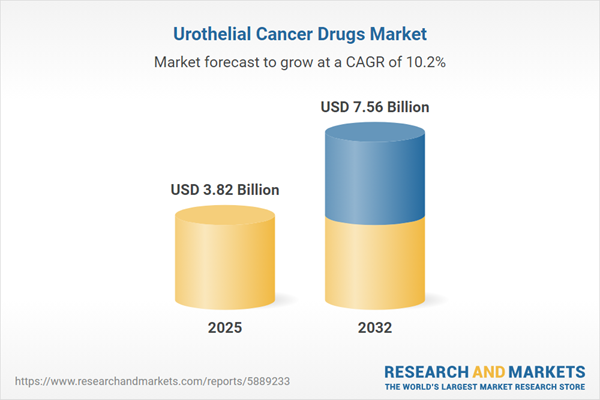Speak directly to the analyst to clarify any post sales queries you may have.
The urothelial cancer drugs market is experiencing accelerated transformation as decision-makers navigate a landscape marked by clinical breakthroughs, therapeutic innovation, and regulatory complexity. This report distills current dynamics and forward-looking perspectives crucial for strategic planning in pharmaceutical oncology.
Market Snapshot: Urothelial Cancer Drugs Market Outlook and Growth Dynamics
The urothelial cancer drugs market is advancing at a robust pace, with new therapeutic modalities and advanced clinical research pipelines shaping the competitive environment. With analytics integrated into oncology practices, stakeholders are achieving greater precision in clinical care and are responding to a heightened demand for personalization. The sophistication of diagnostic tools and adaptive strategies are compelling a reevaluation of how organizations engage both healthcare providers and patients. During this period of transformation, agility in therapeutic development and market adaptation remains critical for industry leaders seeking to maintain relevance and address evolving provider expectations.
Scope & Segmentation of the Urothelial Cancer Drugs Market
This report provides an actionable analysis for senior leaders, examining core market segments, relevant technology adoption, and global market trends critical for strategic positioning. Key areas evaluated include:
- Therapy Types: Antibody-drug conjugates targeting Nectin-4, advancements in chemotherapeutics, and immunotherapy addressing PD-1/PD-L1 pathways form the foundation of next-generation oncology approaches.
- Development Mechanisms: Strategies include FGFR inhibition and introducing innovative agents directed at unique cellular markers to enhance clinical and commercial value.
- Lines of Therapy: Movement between initial and subsequent treatment lines requires aligning with updated clinical guidelines and evolving provider expectations.
- Disease Stages: Distinct approaches for non-muscle invasive, muscle-invasive, and metastatic urothelial cancer ensure care is tailored to each progression stage.
- Administration Routes: Evaluation of patient access and adherence implications for oral versus intravenous delivery highlights practical patient care considerations.
- Treatment Settings: Analysis of usage across hospitals, oncology centers, and outpatient facilities reveals implications for therapy distribution and logistical efficiency.
- Regional Coverage: Insights span the Americas, Europe, Middle East and Africa, and Asia-Pacific, emphasizing market nuances in the United States, China, Germany, and Japan.
- Key Companies: Profiles of Merck & Co., Roche Holding, AstraZeneca, Bristol-Myers Squibb, Pfizer, Merck KGaA, Johnson & Johnson, Astellas Pharma, Seagen, and Gilead Sciences spotlight partnerships and shifting competitive strategies.
Each segment is assessed for its investment value and potential growth, with the impact of advanced technologies and regional strategies providing a practical framework for both new entrants and established market participants.
Key Takeaways
- Next-generation antibody-drug conjugates and innovations in immunotherapy are prompting organizations to refine their research and partnership strategies.
- Biomarker-driven personalization allows treatments to be more precisely aligned to patient profiles, promoting clinical standardization and competitive differentiation.
- Regulatory pathways are becoming more efficient through the use of real-world evidence, facilitating accelerated access to novel therapies and reducing development lead times.
- Collaboration between pharmaceutical and diagnostics stakeholders is improving clinical trial recruitment and expanding therapy options, further supporting diversity in trial populations.
- Digital supply chain investments and local manufacturing are enhancing operational flexibility and supporting more effective responses to market challenges.
- Strategic moves such as mergers, licensing deals, and the adoption of digital tools are crucial for aligning with shifting compliance strategies and achieving sustained therapeutic impact.
Tariff Impact on Supply Chains and Pricing
Recent policy updates in U.S. tariffs are prompting pharmaceutical companies to pursue vertical integration and intensify investments in domestic manufacturing. By establishing robust supplier networks and real-time inventory oversight, organizations manage cost fluctuations and reduce the influence of payer-driven limitations. Engaging with free trade agreements and maintaining strong relationships with trade authorities further supports a stable drug supply chain, protecting patient access amid changing market pressures.
Methodology & Data Sources
The insights in this report are based on comprehensive interviews with oncologists, payers, regulatory professionals, and logistics experts. Findings have been validated with multidisciplinary panels and supported by rigorous secondary research, ensuring relevance and accuracy for leadership teams.
Why This Report Matters
- Delivers practical, real-time analysis to support the development of adaptive market strategies as compliance and commercial landscapes evolve.
- Enables organizations to design more resilient supply chains and optimize market access strategies in response to regulatory and tariff changes.
- Equips senior decision-makers with critical insights for market entry planning, opportunity evaluation, and ongoing positioning in the evolving oncology pharmaceuticals sector.
Conclusion
Success within the urothelial cancer drugs market relies on leadership that champions clinical progress, responds to regulatory shifts, and fosters operational adaptability. Forward-thinking strategies remain essential for long-term relevance and growth.
Additional Product Information:
- Purchase of this report includes 1 year online access with quarterly updates.
- This report can be updated on request. Please contact our Customer Experience team using the Ask a Question widget on our website.
Table of Contents
3. Executive Summary
4. Market Overview
7. Cumulative Impact of Artificial Intelligence 2025
Companies Mentioned
The companies profiled in this Urothelial Cancer Drugs market report include:- Merck & Co., Inc.
- Roche Holding AG
- AstraZeneca PLC
- Bristol-Myers Squibb Company
- Pfizer Inc.
- Merck KGaA
- Johnson & Johnson
- Astellas Pharma Inc.
- Seagen Inc.
- Gilead Sciences, Inc.
Table Information
| Report Attribute | Details |
|---|---|
| No. of Pages | 195 |
| Published | October 2025 |
| Forecast Period | 2025 - 2032 |
| Estimated Market Value ( USD | $ 3.82 Billion |
| Forecasted Market Value ( USD | $ 7.56 Billion |
| Compound Annual Growth Rate | 10.2% |
| Regions Covered | Global |
| No. of Companies Mentioned | 11 |









